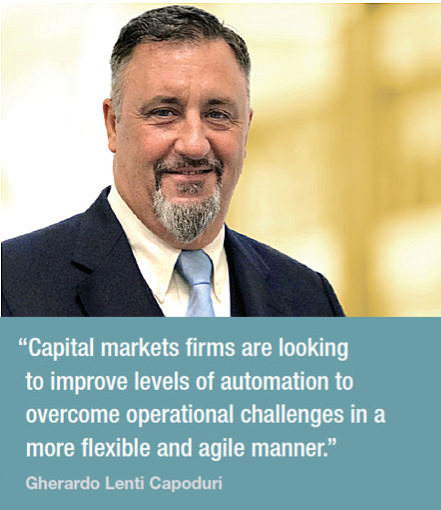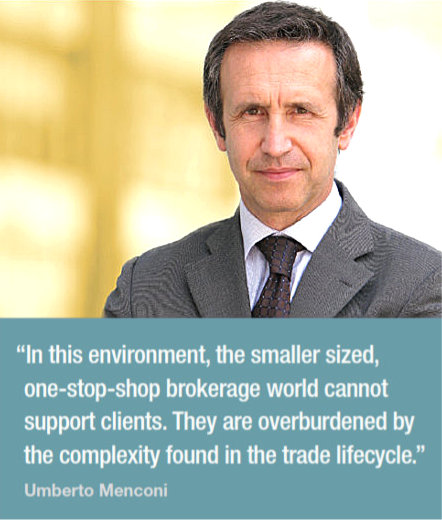Thinking beyond MiFID II: a new role for the fixed income broker
By Gherardo Lenti Capoduri, Head of Market HUB, and Umberto Menconi, Business Development & Market Structure, Market HUB at Banca IMI.
Less than a year from its introduction, MiFID II’s new market infrastructure is still very much in its infancy. The financial industry is focusing on specific areas of regulatory uncertainty. On 4th October The European Securities and Markets Authority (ESMA) released a new Q&A on transparency and market structure; some delayed regulatory obligations are going to kick in over the next few months and, with regards to technical implementation, more efficient and long-term structures are replacing the contingency ones initially established.

As the new transparency parameters and product governance obligations are gradually fitting into place and no major disruption has been felt as a result of the rules so far, investment banks in the European fixed income space are assessing how MiFID II has impacted their business models; which opportunities are arising as a consequence of the new regulations; whether they are ready to face the new challenges posed by cryptocurrency and fintech firms, and competition with new players planning to enter the financial arena, from digital giants to social networks.
A key to making progress after a period in which liquidity has been fragmented across many new, innovative solutions is for market operators, vendors and the whole financial community to find ways of aggregating and integrating their financial services’ proposal along all the front-office and post-trade value chain, and leveraging their own economies of scale in order to counter shrinking margins and a weak macroeconomic environment. In the USA many firms have already anticipated this trend, with recent acquisitions completed by ICE Group, CME Group and IHS Markit.
A new role for fixed income brokers
In this environment, the smaller sized, one-stop-shop brokerage world cannot support clients. They are overburdened by the complexity found in the trade lifecycle, the highly capital-intensive business, increasing digitalisation, regulatory requirements, process efficiencies and cost cutting (which are equally barriers to entry for new participants). The traditional voice broker model is gradually reshaping, and new technologies such as artificial intelligence are creating the potential to transform bond trading. In this scenario, MiFID II is not the instigator of change, but is emphasising a trend which had already gained consensus in recent years: the shift from a voice-execution-centric approach towards more flexible and powerful ‘client experience’ solutions, which can integrate high-touch service and low-touch e-commerce models, thanks to technological innovation and the electronification of process worldwide.
Embracing this trend is a strategic issue, because it requires a complete change of business proposition and organisational mode for many sell-side firms, heavily investing in e-trading and the associated e-commerce services that extend and complement e-trading. This reshaping of the services offering is driven by buy-side client demand for a greater range of e-commerce solutions.
There are three foreseeable options for the sell-side to navigate:
- Significant specialisation in a small, high-value-added and very innovative market niche, in which the broker could build very strong brand awareness;
- Integration of the whole operational process, including liquidity sourcing, multi-asset and multi-market best execution, as well as post-trade operations, offering a more turn-key solution, tailor-made that can be white-labelled fully STP, to provide a more efficient operational flow and lower infrastructure costs;
- Development of a partial or full prime brokerage service, to provide clients with the opportunity of greater focus on servicing end-clients.
Some brokers started this transformation process with MiFID I in 2007, while others are starting later, but a late start makes transformation harder.

To make this process work, brokers must consider some strategic issues caused by regulatory requirements, increased infrastructural complexity, efficiency levels and cost cutting:
- A Systematic Internaliser (SI) and Organised Trading Facility (OTF) cannot co-exist in the same entity. Matching principal and riskless principal activities are permitted to SI only on occasional basis: this regulatory requirement demands a review related to the firm’s trading model;
- New Basel III capital requirements are stressing trading desks suggesting:
– a rebalancing of risk principal and agency broker activity, with lower use of proprietary inventory and more focus on distribution and customer service
– a greater involvement of big buy-side firms in the bond pricing process
– a more collaborative approach between the sell-side and the buy-side in improving market liquidity.
- The fragmented market environment and complexity of controls are supporting the development of smart order routers with hybrid models integrating low-touch and high-touch services.
The adoption of a smart execution model in a multi-asset and multi-market fragmented environment is raising industry interest in data mining, transaction cost analysis (TCA), embedded systems and best execution monitors, which allow a quicker and more consistent evaluation of the firm’s Execution Policy, improving trading venue performance analysis, which should lead to execution model improvement. Data source, quality, analysis and sharing will play a central role within brokers’ strategies because they will need to manage and distribute more data than ever before, especially if they want to provide it to customers in a machine-readable way, as a value-added service via a single-dealer platform or application programming interface (API).

With the same aim of facilitating and improving the ‘client experience’, a broker’s selling proposition can be completed by offering more value-added solutions embedded in the execution service:
- Hedging currency risk exposure coming from order execution
- Liquid repo market service
- High-quality bond delivering service, to avoid mandatory buy-in
- Axes and market information automated delivery system
- Research distribution platform compliant with MiFID II unbundling obligations
- Qualified human resource to cope with this new digital environment and regulatory landscape
While order management systems (OMSs) and execution management systems (EMSs) have evolved towards more automated processes, post-trade operations are coming under scrutiny as a way of brokers re-thinking and simplifying their business models. Capital markets firms are looking to improve levels of automation to overcome operational challenges in a more flexible and agile manner, to provide efficient response to business and regulatory changes and rising costs. A fit-for-purpose strategy might be to integrate pre-trade and liquidity sourcing, execution, settlement, clearing and custody in a single solution with high level of automation and based on the latest standards and frameworks.
While new regulation is trying to achieve transparency and fairness in financial markets, the huge procedural complexity introduced by new obligations has impacted almost all financial market participants. This is particularly evident in the huge reporting obligation under both EMIR and MiFID II. The availability of post-trade transparency services to approved publication arrangements (APAs), as well as authorised reporting mechanisms’ (ARMs) transaction reporting facilities, or mandatory EMIR reporting services have helped to guide the choice of the brokers for many customers and have also supported the decision of many investment banks to be an SI.
Conclusion
A recent GreySpark research report highlighted that “the shift of bank services, particularly of those relating to the trading of securities, onto e-commerce platforms is part of a shift over the past 20 years that increasingly placed e-trading at the fingertips of clients”.
Banks need to broaden their e-commerce products and distribution channels, promoting more integration between high-touch and low-touch services inside a ‘fully-comprehensive client experience’.
©Markets Media Europe 2025























